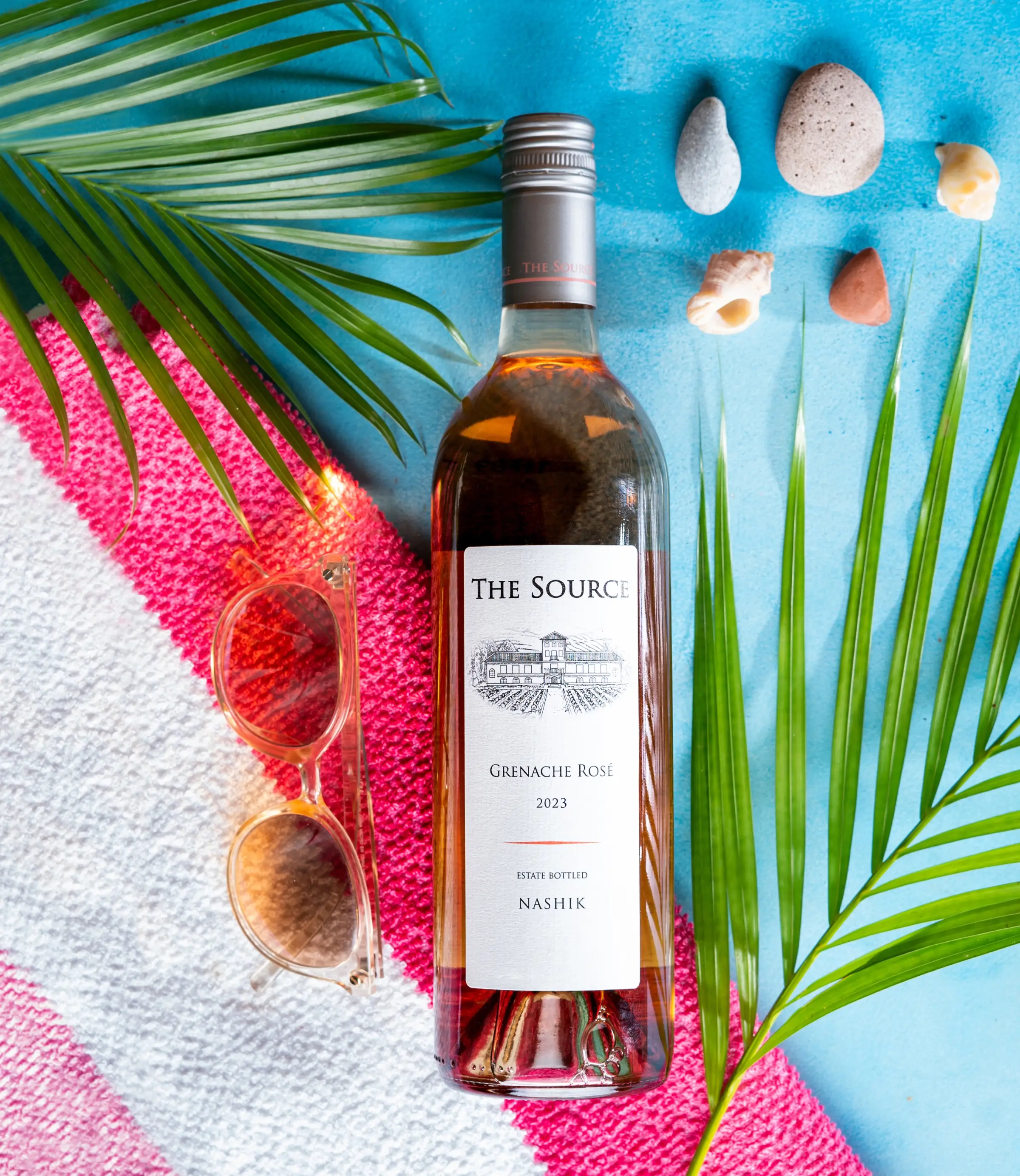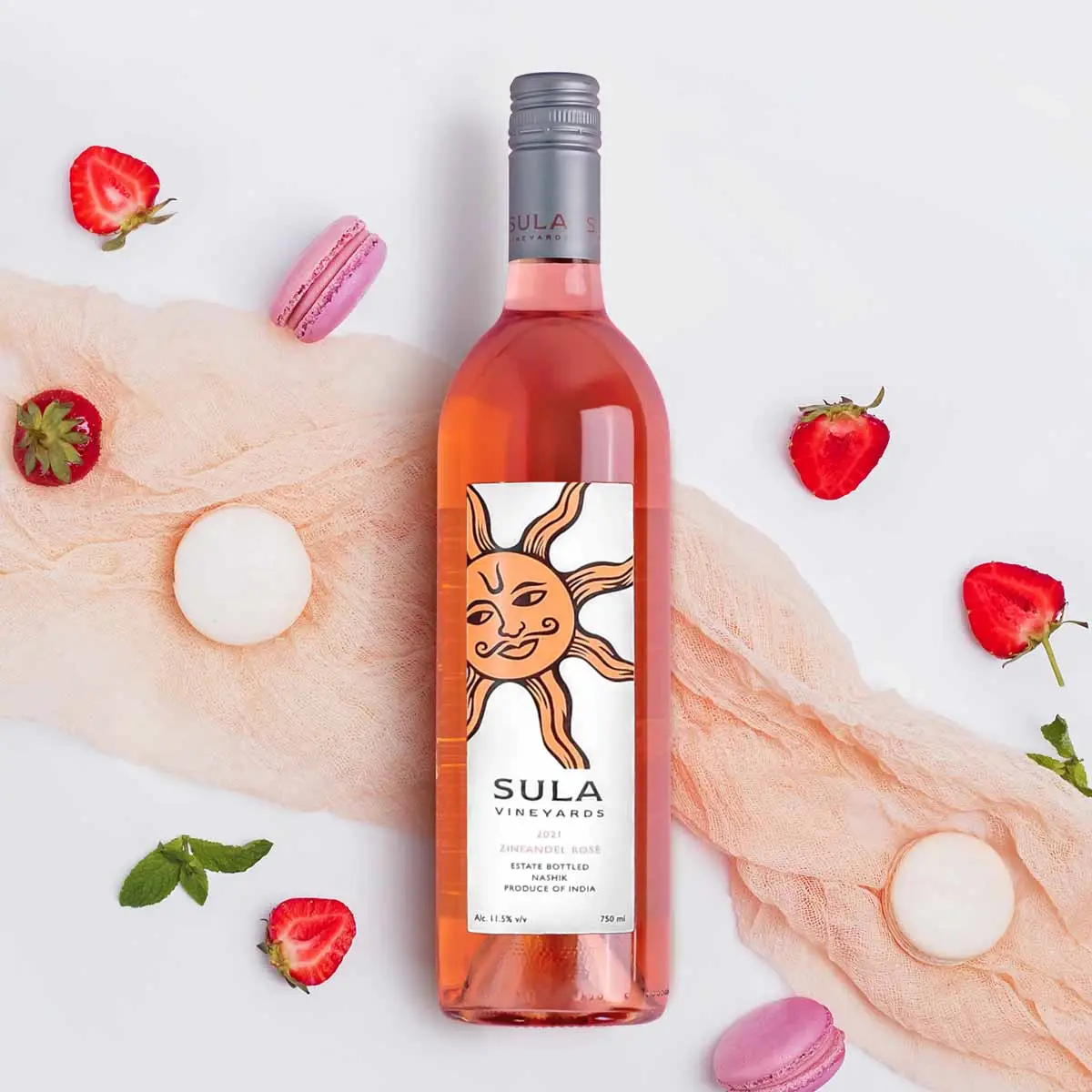There are few things that can put you in a summer state
of mind than a glass of chilled rosé can! However,
contrary to popular belief, this pink-hued wine isn’t
just a summer staple! With Sula’s exciting range of rosé
wines, we’re sure you’ll find the perfect pick for every
occasion, no matter what the season!
But before we talk about Sula’s exciting collection of
rosé wines, let’s first understand the history of this
unique alcoholic beverage that has won millions of
hearts worldwide!
What is Rosé Wine?
If red wine is made with dark-skinned grapes and white
wine is usually derived from light-skinned grapes, does
that mean rosé wine comes from a special grape varietal?
Not at all!
Rosé is a type of wine and doesn't come from one type of
grape. It is made in a manner that's similar to most red
wines, but the fermentation period is shorter. In most
cases, the time the mush spend in contact with the grape
skin is shorter. Since the grape skins are responsible
for adding colour to the wine, the reduced contact in
the case of rosé wine brings to life its signature pink
hue.
Until a few decades ago, fine rosé wine was usually made in
the Provence region of France using grape varietals like
Syrah and Grenache. Back then, rosé wine was viewed as
'inferior' to red wine. In fact, when grape varietals
didn't grow well enough to be made into red wine,
winemakers would use them to make rosé.
However, rosé is a very versatile wine and can be made
from virtually any grape varietal. In recent times,
winemakers in the United States, Spain, Italy, and India
have begun experimenting with various styles of rosé wine
because of the increase in demand for this lovely wine!
How Rosé Is Made
Although we spoke about how rosé wine is made, let’s take a closer look at the most popular methods for making this wine.
Maceration or ‘Skin Contact’
Considered to be the most popular method of producing
rose, this traditionally French winemaking process is
still one of the most widely spread ways of making rose.
In this method, grapes are grown and harvested a little
earlier in the harvest cycle with the singular aim of
turning them into rosé.
These grapes are pressed first, and then the macerated
mixture is kept in contact with juice that contains the
grape skins for anywhere between two to twenty-four
hours.
Since the grape skins are in contact with the juice,
this method is called the 'skin contact' method.
Saignée or ‘Bleeding’
In the bleeding method of making rose, where a small
amount of grape juice used to make red wine is 'bled
off' during the early stages of fermentation. This
separated juice is then used to make rosé. The bleeding
method was originally popularized by Italian winemakers,
who found that this process led to an end product with a
more vibrant pink hue.
However, this traditional Italian method is now being
taken over by the “French” method of making rose.
Blending
With the blending method of making rose, a small amount of red wine is added to a tank containing white wine. This may often seem like the simplest way of getting beautiful rosé wines, but this seemingly simple method is not nearly as popular today as it once was.
The Rosé Wines of Sula
Now that we’ve had a look at the history, winemaking methods, and health benefits of rosé, let’s take a look at Sula’s exciting repertoire of rosé wines.
THE SOURCE GRENACHE ROSÉ

Made using 100% hand-harvested Grenache grapes, this
exciting rosé is pressed only for an hour or two that
gives it a light, peachy, rosy hue that’s usually
associated with Grenache rosés. Once the pressing cycle
ends, the juice is drained and chilled before being
transferred to a fermentation tank, where it matures for
three weeks. This intensive process ensures that no
residual sugar is left in the wine, making for an end
product that's low on sweetness.
The Source Grenache Rosé won the award for ‘Best
in Show’ at the India Wine Awards 2019. It has bright
acidity, mild citrus notes with aromas of tropical fruit
and white peach, and a smooth, elegant finish. Owing to
its low alcohol content, it also makes for great sipping
wine.
For best results, pair this sensational wine with the
delicate flavours of grilled fish or shellfish. It also
combines beautifully with barbequed meats, delicious
salads, Mediterranean preparations like falafel, and
dishes with complex savoury-sweet flavours like samosa
chaat.
SULA ZINFANDEL ROSE
Sula Zinfandel Rosé is made from 100% hand-picked
Zinfandel grapes, and it also holds the distinction of
being India's first-ever Zinfandel Rosé. Best described
as fresh, fruity and ripe, this wine has intense notes
of citrus, cranberry, and ripe stone fruits, with aromas
of strawberries and cranberries.
Although this wine is medium-sweet, it has intense
fruitiness, making it an apt choice to be sipped on
throughout the Indian summers. However,
Sula's Zinfandel Rosé is very versatile and can
be enjoyed almost anytime through the year.
This rosé wine tastes divine with lightly prepared
poultry dishes, spicy meat preparations, Indian-style
fritters, and even Indo-Chinese appetizers like Paneer
Chili. When it comes to cheese pairing, fresh mozzarella
and other delicate variants go well with this wine.
However, it’s best not to pair this rosé with strong
aged cheese like gouda, gorgonzola or sharp cheddar as
they may overpower the wines subtle notes.

Storing And Serving Rosé Wine
When it comes to bringing out the best in rosé wines,
the temperature is an important factor to consider.
However, with that being said, it’s best to serve these
wines slightly chilled. If you skip this step and serve
it warm, it may end up tasting very alcoholic, whereas
over-chilled rose can taste ‘thin’ and flavourless.
In the case of unopened rosé wines, it’s best to store
these bottles on their sides in a wine rack. However,
unless your bottle has a cork stopper, this step isn’t
that important. For best results, store your bottles of
rosé in a cool, dry place with minimal direct light to
preserve their taste and aromas. Wine refrigerators are
a great option for maintaining the right temperature.
Once your bottle of rosé has been opened, store it in
the refrigerator and try to finish it within three to
four days. By keeping your bottle vertically stored in
the fridge, you slow down the wine’s natural oxidation
process, prolonging its shelf life.
Final Thoughts
We hope that this in-depth guide to rosé wines has given
you an in-depth understanding of your favourite type of
wine. At Sula, we work hard to employ
environment-friendly and sustainable
practices in everything we do, which is why it
brings us great joy to see you enjoy the fruits of our
labour!
Want to stay updated with the latest in the world of
wines? Follow us on Instagram , Facebook , and
Linkedin
today!






